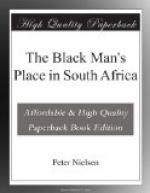Many people think that the coloured people in South Africa, who are most numerous in the vicinity of Cape Town, but are also scattered all over the country, will form, as it were, a bridge between the two sections of the population for their eventual coalescence. But when this conclusion is closely examined it is seen to rest on debatable premises, for it is admitted that by far the greater part of the miscegenation that is now going on is between white men and coloured or black women and not between coloured or black men and white women, from which it follows, as has been pointed out by Boas,[24] that, as the numbers of children born does not depend upon the numbers of men but upon the numbers of women, the result will be a bleaching of the black element, here and there, and not a darkening of the whites in South Africa.
Statistics have, indeed, been quoted which show that between the year 1904 and the year 1911 the coloured population increased in the Cape Province by fifteen per cent, while the total population increased by only six and a half per cent., but these figures do not show how much of the coloured increase is due to propagation among coloured people themselves and how much to unions between white men and coloured women. When it is noted that in the year 1911 the European increase over the year 1904 in the whole Union of South Africa was 14.28 per cent., and that of all non-European elements only 15.12 per cent., it will be seen that although the black increase is on a larger basis it hardly justifies alarm over an imagined flood of overwhelming coloured numbers.




